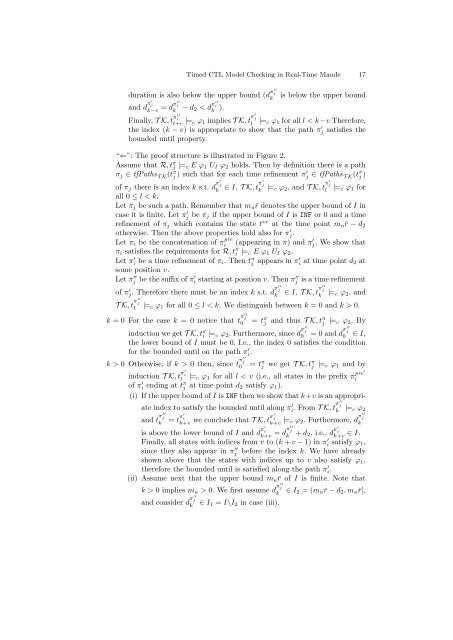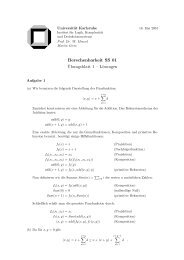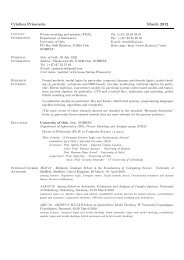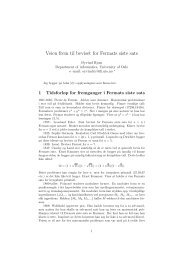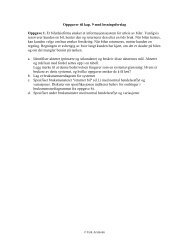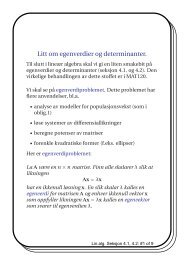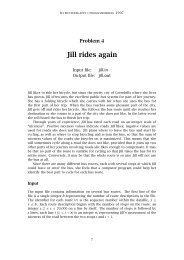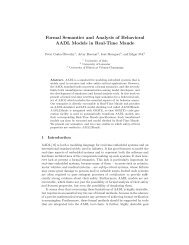Timed CTL Model Checking in Real-Time Maude⋆ - IfI
Timed CTL Model Checking in Real-Time Maude⋆ - IfI
Timed CTL Model Checking in Real-Time Maude⋆ - IfI
Create successful ePaper yourself
Turn your PDF publications into a flip-book with our unique Google optimized e-Paper software.
<strong><strong>Time</strong>d</strong> <strong>CTL</strong> <strong>Model</strong> <strong>Check<strong>in</strong>g</strong> <strong>in</strong> <strong>Real</strong>-<strong>Time</strong> Maude 17<br />
duration is also below the upper bound (d π′′<br />
i<br />
k is below the upper bound<br />
and d π′<br />
j<br />
k−v<br />
i = dπ′′<br />
k − d2 < d π′′<br />
i<br />
k ).<br />
F<strong>in</strong>ally, T K, t π′′ i<br />
l+v |=c ϕ1 implies T K, t π′<br />
j<br />
l |=c ϕ1 for all l < k−v Therefore,<br />
the <strong>in</strong>dex (k − v) is appropriate to show that the path π ′ j satisfies the<br />
bounded until property.<br />
“⇐”: The proof structure is illustrated <strong>in</strong> Figure 2.<br />
Assume that R, t π j |=c E ϕ1 UI ϕ2 holds. Then by def<strong>in</strong>ition there is a path<br />
πj ∈ tfPaths T K(t π j ) such that for each time ref<strong>in</strong>ement π′ j ∈ tfPaths T K(t π j )<br />
of πj there is an <strong>in</strong>dex k s.t. d π′ j<br />
j<br />
k ∈ I, T K, tπ′<br />
k |=c ϕ2, and T K, t π′<br />
j<br />
l |=c ϕ1 for<br />
all 0 ≤ l < k.<br />
Let πj be such a path. Remember that mu¯r denotes the upper bound of I <strong>in</strong><br />
case it is f<strong>in</strong>ite. Let π ′ j be πj if the upper bound of I is INF or 0 and a time<br />
ref<strong>in</strong>ement of πj which conta<strong>in</strong>s the state t∗∗ at the time po<strong>in</strong>t mu¯r − d2<br />
otherwise. Then the above properties hold also for π ′ j .<br />
Let πi be the concatenation of π pre<br />
i (appear<strong>in</strong>g <strong>in</strong> π) and π ′ j . We show that<br />
πi satisfies the requirements for R, tπ i |=c E ϕ1 UI ϕ2.<br />
Let π ′ i be a time ref<strong>in</strong>ement of πi. Then tπ j appears <strong>in</strong> π′ i at time po<strong>in</strong>t d2 at<br />
some position v.<br />
Let π ′′<br />
j be the suffix of π′ i start<strong>in</strong>g at position v. Then π′′ j is a time ref<strong>in</strong>ement<br />
of π ′ j<br />
T K, t π′′<br />
j<br />
l<br />
j<br />
. Therefore there must be an <strong>in</strong>dex k s.t. dπ′′<br />
k<br />
j<br />
∈ I, T K, tπ′′<br />
k |=c ϕ2, and<br />
|=c ϕ1 for all 0 ≤ l < k. We dist<strong>in</strong>guish between k = 0 and k > 0.<br />
k = 0 For the case k = 0 notice that t π′′<br />
j<br />
0 = tπ j and thus T K, tπ j |=c ϕ2. By<br />
<strong>in</strong>duction we get T K, t π i |=c ϕ2. Furthermore, s<strong>in</strong>ce d π′′<br />
j<br />
0<br />
j<br />
= 0 and dπ′′ 0<br />
∈ I,<br />
the lower bound of I must be 0. I.e., the <strong>in</strong>dex 0 satisfies the condition<br />
for the bounded until on the path π ′ i .<br />
k > 0 Otherwise, if k > 0 then, s<strong>in</strong>ce t π′′<br />
j<br />
0 = tπj we get T K, tπj |=c ϕ1 and by<br />
<strong>in</strong>duction T K, t π′<br />
i<br />
l |=c ϕ1 for all l < v (i.e., all states <strong>in</strong> the prefix π pre′<br />
i<br />
of π ′ i end<strong>in</strong>g at tπj at time po<strong>in</strong>t d2 satisfy ϕ1).<br />
(i) If the upper bound of I is INF then we show that k+v is an appropri-<br />
ate <strong>in</strong>dex to satisfy the bounded until along π ′ j<br />
i . From T K, tπ′′<br />
k |=c ϕ2<br />
and t π′′<br />
j i<br />
i<br />
k = tπ′<br />
k+v we conclude that T K, tπ′<br />
k+v |=c ϕ2. Furthermore, d π′′<br />
j<br />
is above the lower bound of I and d π′<br />
i<br />
j<br />
k+v = dπ′′<br />
k + d2, i.e., d π′<br />
i<br />
k+v ∈ I.<br />
F<strong>in</strong>ally, all states with <strong>in</strong>dices from v to (k + v − 1) <strong>in</strong> π ′ i satisfy ϕ1,<br />
s<strong>in</strong>ce they also appear <strong>in</strong> π ′′<br />
j before the <strong>in</strong>dex k. We have already<br />
shown above that the states with <strong>in</strong>dices up to v also satisfy ϕ1,<br />
therefore the bounded until is satisfied along the path π ′ i .<br />
(ii) Assume next that the upper bound mu¯r of I is f<strong>in</strong>ite. Note that<br />
k > 0 implies mu > 0. We first assume d π′′<br />
j<br />
k ∈ I2 = (mu¯r − d2, mu¯r],<br />
and consider d π′′<br />
j<br />
k ∈ I1 = I\I2 <strong>in</strong> case (iii).<br />
k


